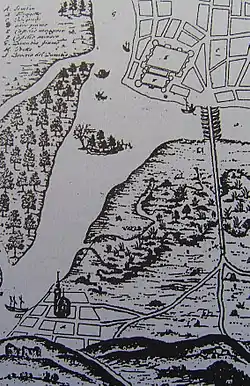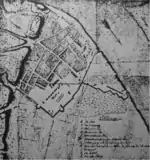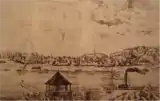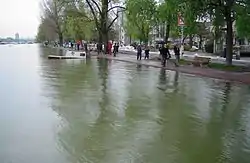Timeline of Zemun history
The following tables list the main events in history of Zemun (part of Belgrade, Serbia).
Ancient times and Middle Ages

Remains of a Roman sarcophagus found in Zemun

Relief of a maenad, found in Zemun

Taurunum on Tabula Peutingeriana
| Dates | Events |
|---|---|
| Before Common Era | Neolithic settlement; Scordisci, Romans and Celts are mentioned as rulers of the area |
| 1st quarter of 1st century CE | Romans found Taurunum, after a rebellion of Celts in 6–8 AD |
| 1st century CE | Pliny mentions Taurunum as the second most important settlement in Syrmia |
| 4th century CE | Taurunum appears on Tabula Peutingeriana, a map of Roman road network |
| around 440 | Huns destroy Taurunum; no further mentioning of a settlement for several centuries |
| 5th - 8th century | Ostrogoths, Lombards and Avars ruled the area |
| 795 | Franks conquer Syrmia; this was followed by colonization, including Zemun; however, it is unclear how the Francs called the settlement |
| 827 | Bulgarian Empire conquers Zemun and call it Земльн (Zemlyn - (town) made of earth) |
| end of 9th century | The Kingdom of Hungary conquers Zemun and call it Zimony |
| 1018 | Acquisition by the Byzantine Empire |
| 1071 | Kingdom of Hungary reconquers Zemun |
| 1096 | Crusaders of the First Crusade burn Zemun and kill 8,000 Zemuners; because they were routed at first, they call Zemun Malevilla (Evil Town) |
| 1128 | Kingdom of Hungary, under Stephen II, destroys Belgrade and use the masonry to reinforce Zemun fort |
| 1151 | Byzantines plunder and burn Zemun and reuse its masonry to reinforce Belgrade fortress; however, by the terms of peace treaty, Kingdom of Hungary retake Zemun |
| summer 1164 | Byzantines burn Zemun and kill most of its inhabitants |
| 1166 | Kingdom of Hungary retakes Zemun |
| 1241 | Mongols conquer the area for a short while |
| 1260 | First mentioning of Franciscans in Zemun |
| 1268 | Serbs acquire Syrmia as a dowry by Elizabeth the Cuman, Hungarian princess to king Dragutin; Serbs call the town Земун (Zemun) - the name it bears today |
| 1319 | Kingdom of Hungary conquers Syrmia, including Zemun |
| 1353 | Serbian emperor Dušan conquers Syrmia |
| Around 1370 | Reconquest of Syrmia by the Kingdom of Hungary |
| 1396 | Ottoman Turks plunder Zemun |
| 1412 | Zemun, along with some other towns, is acquired by Serbs, by the treaty between Serbian despot Stefan and Hungarian king Sigismund |
| 1434 | Kingdom of Hungary acquires Zemun as a dowry of Serbian despot Đurađ's daughter Catherine to Hungarian count Ulrich II of Celje |
| 1453 | Ottomans destroy the Franciscan church and convent in Zemun |
| Around July 10, 1521 | Ottomans burn and plunder Zemun; it remains under their control for almost 200 years, with very few written traces from this period |
| August 1521 | Ottoman sultan Suleiman the Magnificent spends the whole month in Zemun directing the siege of Belgrade |
| 1573 | First mentioning of an Orthodox church in Zemun |
Early modern period

Ottoman Zemun in 1608

Map of Zemun from 1688

Signing of Belgrade Treaty

Dimitrije Davidović

Zemun in 1791

Map of Zemun Contumaz from 1830

Zemun around 1850

Millennium tower

Danube at Zemun in April 2006
| Dates | Events |
|---|---|
| 1688 | Habsburgs burn and plunder Zemun; they call it Semlin |
| 1690 | Ottomans retake Zemun |
| July 1, 1717 | Eugene of Savoy conquers Zemun;[1] it remained under the Habsburgs for the next 201 years |
| 1728 | First Zemun school is established by the friar order of Capuchins; Zemun and surrounding lands in Syrmia are given to Schönborn family[1] |
| 1730 | A quarantine zone, so-called Contumaz is built (dismantled in 1842) |
| 1739 | Ottomans retake Belgrade; many Christians flee to Zemun |
| September 18, 1739 | Treaty of Belgrade, between the Ottoman Empire and Habsburg Monarchy, is signed at Zemun bank of Sava |
| December 25, 1744 | First Catholic mass is held in Zemun |
| 1745 | Zemun is part of the re-established Syrmia County in the Croatian Kingdom of Slavonia |
| 1746 | Zemun becomes part of Austrian Military Frontier |
| Autumn 1751 | Zemun Community Magistrate, a local government institution, is formed; Marko Nikolić is appointed the first Town Mayor (officially: "Town Judge") in Zemun's history |
| 1772 | Census is held; Zemun has 3,829 inhabitants, 12 guilds, 2 taverns and 6 watermills |
| 1776 | First synagogue in Zemun is mentioned |
| 1779 | First brewery in Zemun is mentioned |
| 1788 | At the start of Austro-Turkish War, Austrian emperor Joseph II assembles troops at Zemun to conquer Belgrade;[2] First street signs are put up[1] |
| April 1789 | First hospital in Zemun, and the oldest one in today's Serbia, is built |
| October 12, 1789 | Dimitrije Davidović, the author of first Serbian Constitution and the establisher of first Serbian newspapers, is born in Zemun |
| 1801 | Zemun has 7,089 inhabitants (mostly Serbs, Germans, Greeks, Aromanians, Jews, etc.) and 1,464 families[1] |
| October 18 to 20, 1817 | Emperor Franz I visits Zemun; town's freshly established, German-populated suburb is named Franzthal in his honor |
| January 26, 1825 | First library in Zemun, and the oldest one in today's Serbia, is established |
| April 1848 | Along with other contemporary revolutions, citizens of Zemun forced the town government to give up their authority; after a brief period of anarchy, they formed the Town council; this lasted until August 1849. For most of the revolution, Zemun was the capital of Serbian Vojvodina |
| 1848–1852 | Representatives from Zemun were part of the Croatian Sabor[3][4] |
| July 5, 1852 | Emperor Franz Joseph I visits Zemun[5] |
| 1853 | Telegraph service was established between Zemun, Petrovaradin and Kikinda[1] |
| September 23, 1858 | Zemun High School is officially established; initially, it has 21 students |
| May 29, 1867 | Austrian Empire transforms into Austria-Hungary |
| January 1, 1871 | Zemun is proclaimed Free Imperial Town; Community Magistrate is replaced by Town Government |
| April 1876 | Eastern parts of Zemun are flooded by Danube; damage is estimated to 150,000 forints |
| 1879 to 1886 | In the place where Contumaz stood, Town Park (Gradski park) of 7.7 hectares is planted |
| 1881 | Zemun and the Croatian-Slavonian military frontier is incorporated into the Triune Kingdom of Croatia, Dalmatia and Slavonia |
| December 10, 1883 | Railway track between Budapest and Zemun is finished; one year later, Zemun is also connected to Belgrade |
| 1886 to 1889 | Zemun quay, a several kilometres long levee, is built |
| spring 1895 | Once more, Danube flooded Zemun; this time, the damage was estimated to 200,000 forints |
| 1896 | Millennium Tower is erected in Zemun, to mark 1000 years of Hungarian state; today, the tower is the most famous Zemun landmark |
| December 1900 | Electric street lighting is installed and put to function |
20th and 21st century
| Dates | Events |
|---|---|
| 1904 | First cinema showing; Zemun's first movie theatre was opened in 1908[1] |
| July 28, 1914 | World War I begins with shelling of Belgrade (Serbia) from Zemun (Austria-Hungary); On September 10, Serbian army conquers Zemun, but is forced to retreat three days later |
| October 29, 1918 | Kingdom of Croatia, Dalmatia and Slavonia declares independence from Austria and Hungary and enters the State of Slovenes, Croats and Serbs with Zemun part of it.[6][7] |
| November 5, 1918 | Serbian army enters Zemun |
| November 25, 1918 | Great National Assembly of Serbs, Bunjevci and other Slavs declared joining of the province of Banat, Bačka and Baranja with Kingdom of Serbia mentioning Syrmia, but was disputed by the National Council of the State of Slovenes, Croats and Serbs.[8] |
| December 1, 1918 | The State of Slovenes, Croats and Serbs (with Zemun part of it) entered a union with the Kingdom of Serbia to form Kingdom of Serbs, Croats and Slovenes |
| April 1919 | The famous Simplon-Orient-Express train connecting Paris to Istanbul starts running through Zemun daily |
| 1921 | A census is held; Zemun has 18,528 inhabitants |
| March 25, 1927 | A civil/military airfield, the first in Kingdom of S, C. and S., begins operation on the outskirts of Zemun; the first domestic commercial flight (Zemun–Zagreb) was on February 15, 1928 |
| 1928 | Kingdom's Air Force Headquarters are situated in Zemun |
| January 6, 1929 | Kingdom of S, C. and S. is renamed to Kingdom of Yugoslavia |
| 1932 | Faculty of Agriculture And Forestry is moved to Zemun |
| April 1, 1934 | Zemun becomes a municipality of the City of Belgrade |
| 1935 | In January, Zemun gets connected to Belgrade by a bus line across the newly built King Alexander Bridge; on November 5, a tram line also connects Zemun to Terazije |
| April 6, 1941 | Nazi Germany bombs Belgrade in World War II; Zemun remains almost intact |
| April 12, 1941 | Axis forces enter Zemun; on October 10 it becomes part of Independent State of Croatia |
| December 1941 | On Zemun bank of the Sava, Sajmište concentration camp (officially: Judenlager Semlin) is built; more than 10,000 people perish in it until September 1944, when it was dismantled |
| July 27, 1942 | Nazis deport the remaining Zemun Jews to extermination camps of Jasenovac and Stara Gradiška |
| April to September 1944 | Belgrade and Zemun are heavily bombed by Allied Forces |
| October 22, 1944 | Partisans and Red Army enter Zemun; it becomes part of Democratic Federal Yugoslavia (since 1945, Federal People's Republic of Yugoslavia) |
| October 22, 1945 | Once again, Zemun becomes a municipality of City of Belgrade |
| 1952 | A part of Zemun municipality is seceded to form Novi Beograd |
| September 9, 1952 | In Yugoslavia's worst ship disaster, more than 90 people perish as passenger ship Niš sinks in a hailstorm on its regular route from Belgrade to Zemun |
| April 28, 1962 | A new, larger airport begins operation in Zemun municipal territory; the old airfield ceases operation in 1964 |
| April 1963 | FPRY is renamed to Socialist Federal Republic of Yugoslavia |
| 1950s – 1980s | Along with Belgrade's population boom, the population of Zemun triples as many new neighbourhoods are built |
| April 27, 1992 | After the breakup of SFRY, Serbia and Montenegro form Federal Republic of Yugoslavia |
| mid-1990s | Some 40,000 refugees of Yugoslav wars settle in Zemun municipality |
| April 1999 | Air Force headquarters is damaged and military barracks in Zemun are destroyed in NATO bombing of Yugoslavia |
| February 4, 2003 | Federal Republic of Yugoslavia is renamed to Serbia and Montenegro |
| March 12, 2003 | Serbian Prime Minister Zoran Đinđić is assassinated in Belgrade; many of the conspirators belonged to Zemun Clan |
| November 24, 2003 | A large area of Zemun municipality is seceded to form Surčin municipality |
| March 16, 2006 | Belgrade is elected Southern European City of the Future |
| April 2006 | The Danube rises to the very edge of Zemun quay, but doesn't flood it, except at its few lowest points |
| June 5, 2006 | After the secession of Montenegro, Republic of Serbia proclaims independence |
| October 2011 | Census, the last one to date, is held; town of Zemun has over 150,000 inhabitants and municipality – over 165,000 |
| December 18, 2014 | Pupin Bridge, Zemun's first ever bridge across the Danube is opened for traffic |
See also
References
- Zemunske novine - Archived from Doba austro-turskih ratova i vladavina Austrije od 1717. do 1918. godine, March 12, 2017 (in Serbian)
- Virginia Aksan – Ottoman Wars, 1700-1870: An Empire Besieged, 2007, ISBN 978-0-582-30807-7, p. 163
- Tanner, Marcus (2001). Croatia : a nation forged in war (2nd ed.). New Haven; London: Yale University Press, p. 86-87
- Tanner, Marcus (2001). Croatia : a nation forged in war (2nd ed.). New Haven; London: Yale University Press, p. 104
- Podunavka #4, March 24, 1856 (in Serbian)
- Hrvatska Država, newspaper Public proclamation of the Sabor 29.10.1918. Issued 29.10.1918. no. 299. p.1.
- Budisavljević Srđan, Stvaranje Države SHS, (Creation of the state of SCS), Zagreb, 1958, p. 133.-135.
- Budisavljević Srđan, Stvaranje Države SHS, (Creation of the state of SCS), Zagreb, 1958
Sources
- Petar Marković - „Zemun od najstariji dana pa do danas“, Zemun, 1896; reprinted 2004, ISBN 86-84149-08-4
- „Hrvatska revija“ - „Hrvatska strana Zemuna“, 2004
- Statistical Office of Serbia - "Census in Serbia 2011 – First Results"
This article is issued from Wikipedia. The text is licensed under Creative Commons - Attribution - Sharealike. Additional terms may apply for the media files.